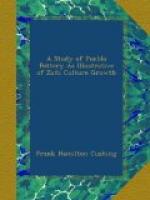These and especially kindred forms of basket-vessels were often quite elaborately ornamented, either by the insertion at proper points of dyed wrapping-splints, singly, in pairs, or in sets, or by the alternate painting of pairs, sets, or series of stitches. Thus were produced angular devices, like serrated bands, diagonal or zigzag lines, chevrons, even terraces and frets. (See Figs. 507, 508, 509.) There can be no doubt that these styles and ways of decoration were developed, along with the weaving of baskets, simply by elaborating on suggestions of the lines and figures unavoidably produced in wicker-work of any kind when strands of different colors happened to be employed together. Even slight discolorations in occasional splints would result in such suggestions, for the stitches would here show, there disappear. The probability of this view of the accidental origin of basket-ornamentation may be enhanced by a consideration of the etymology of a few Zuni decorative terms, more of which might be given did space admit. A terraced lozenge (see Figs. 510, 511), instead of being named after the abstract word a wi thlui ap i pae tchi na, which signifies a double terrace or two terraces joined together at the base, is designated shu k’u tu li a tsi’ nan, from shu e, splints or fibers; k’u tsu, a double fold, space, or stitch (see Figs. 512, 513); li a, an interpolation referring to form; and tsi’ nan, mark; in other words, the “double splint-stitch-form mark.” Likewise, a pattern, composed principally of a series of diagonal or oblique parallel lines en masse (see Fig. 514), is called shu’ k’ish pa tsi nan, from shu e, splints; k’i’sh pai e, tapering (k’ish pon ne, neck or smaller part of anything); and tsi nan, mark; that is, “tapering” or “neck-splint mark.” Curiously enough, in a bottle-shaped basket as it approaches completion the splints of the tapering part or neck all lean spirally side by side of one another (see Fig. 515), and a term descriptive of this has come to be used as that applied to lines resembling it, instead of a derivative from ae’s sel lai e, signifying an oblique or leaning line. Where splints variously arranged, or stitches, have given names to decorations—applied even to painted and embroidered designs—it is not difficult for us to see that these same combinations, at first unintentional, must have suggested the forms to which they gave names as decorations.
[Illustration: FIG. 510. FIG. 511.
Terraced
lozenge decoration, or
“double-splint-stitch-forms.”]
[Illustration: FIG. 512. FIG. 513.
Double-splint-stitch.]
[Illustration: FIG. 514.—Diagonal parallel-line decoration.]
[Illustration: FIG. 515.—Splints at neck of unfinished basket.]
[Illustration: FIG. 516. FIG. 517.
Examples
of indented decoration on corrugated ware.]




